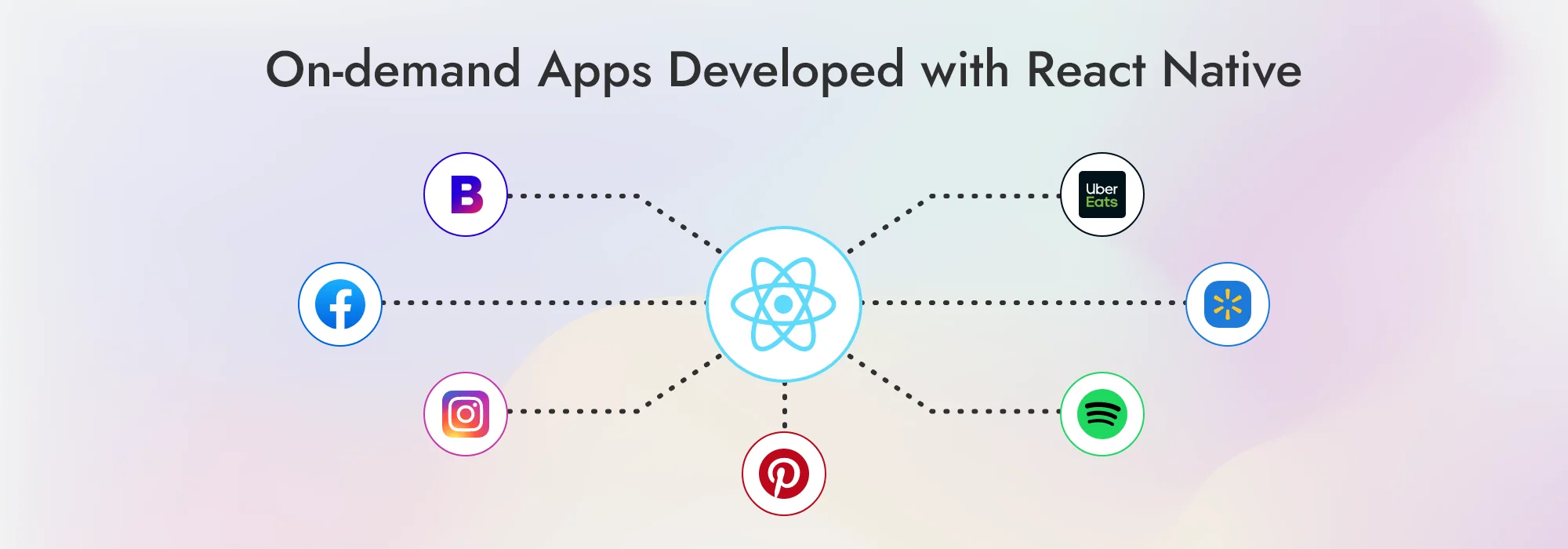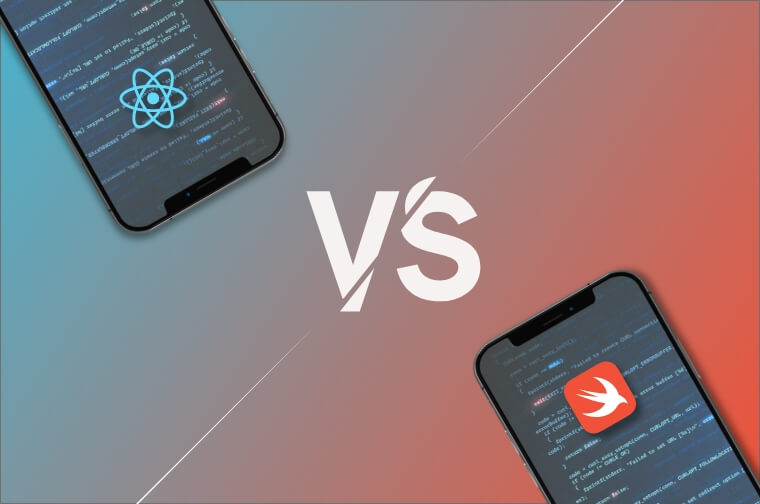Machine Learning and AI for revolution of Tech Companies are changing and streamlining businesses.
This post conducts a comprehensive and in-depth comparison of two of the most used iOS app development technologies: React Native vs Swift. Exploring React Native and Swift, the two powerful tools that are frequently used by developers, will help build native mobile apps more efficiently. Swift is primarily a development language intended for iOS, whereas React Native is focused on building apps that work across multiple platforms.
Choosing between React Native and Swift depends on many factors such as the functioning of the desired app, budget, and target audience. That’s why we’re here to explore the differences between these potent front-end development frameworks, so you can confidently select the best option for your forthcoming app project.
What is react native?

Released and maintained by the social media giant – Facebook in 2015, React Native is an open-source JavaScript programming framework. The key objective behind introducing this framework was to facilitate cross-platform app development and boost the process of mobile app development.
Simply put, React Native lets you use a similar code base to develop native-looking apps for both Android and iOS platforms. This feature aids in decreasing the development time required to create cross-platform applications, ultimately resulting in significant cost savings for businesses seeking to build their applications across multiple platforms.
Backed by the JavaScript library, the most used programming language, React Native lets developers use up to 70% of the same code across different platforms such as iOS, Android and Windows. So, if your business plans to launch a cross-platform app in the shortest possible time, React Native is your go-to choice.
With our understanding of React Native established, let’s talk about the Pros and Cons of the framework in detail before we compare React Native Vs Swift.
Pros and cons of react native
Undoubtedly, React Native has gained immense popularity among iOS app developers and individuals who are considering investing in iOS app development. However, this app development framework has its limitations.
Before investing in your next iOS app development project with React Native, take the time to review the pros and cons of this framework to maximize your investment.
The pros of react native for ios app development
Here are the pros of using React Native for iOS app development:
- Superior Performance: As native apps are built for a particular operating system, they take maximum advantage of the processing speed of the device. In addition to high-speed functioning, they also ensure seamless user experience and flawless performance with a well-designed UI.
- Live Reloading: This feature enables React Native app developers to immediately visualize their code in a preview window. Developers can see real-time changes and avoid the need for redevelopment or redeployment of the app. This results in time-saving, better code quality and higher productivity.
- Extensive Library Support: When comparing Swift vs React Native, the former has almost 33,000 libraries and packages, compared to Swift’s mere 3,800 packages. While the figures alone don’t guarantee the quality of the language or its framework, they demonstrate the community’s dedication and passion to contribute to the technology’s future development.
- Reduced Time to Market: React Native’s platform independence leads to reduced development cycles and faster time-to-market. By writing a single codebase, and with a few native tweaks, deployment on both platforms is possible.
- Create Feature-rich Apps: React Native’s easy integration of native device features and third-party libraries allows for the creation of feature-rich mobile apps. For example, a React Native app can use device features such as GPS, camera and Touchscreen, and can be easily integrated with VR, AI, IoT and AR technologies to build groundbreaking apps.
- Faster Development: Features like using a common codebase across both platforms and hot loading help React Native app developers reduce development time.
- Cost-Effective: React Native lessens the cost of iOS app development by minimizing the need for native developers and permitting the use of open-source libraries. This can lead to substantial savings in development costs.
- Easy to Debug: React Native offers developers a selection of essential debug tools, including the Flipper tool and React DevTools, which can significantly accelerate the bug detection and fixing process.
- Quick App Updates (QAU): This React Native feature allows developers to eliminate the conventional approach of releasing app updates for the users and deploy their app updates directly in user devices using OTA (Over the air) feature.
The cons of react native for ios app development
Here are the cons of using React Native for iOS app development:
- Complex Design for Custom UI: Both iOS and Android platforms have their own set of guidelines for publishing apps in their respective app stores. This turns into a huge problem for React Native app developers, as they find it challenging to create a high-quality custom user interface in their app development.
- Testing is more Intensive: When we compare React Native vs Swift, building multi-platform apps is certainly faster in React Native due to its script-sharing feature. However, the testing process in React Native is extended. Testing React Native apps requires more precision and effort since errors are more likely to arise on both platforms.
- Limited Wrappers: Integrating native modules, components, and APIs into projects may require developers to write custom wrappers, and this process will demand more time.
- Security Challenges: React Native, a popular choice among iOS app developers, has security challenges due to its open-source JavaScript framework. The loosely typed language allows variables to contain anything, making it a potential security threat. Developers building financial and banking apps must add security patches to address these issues.
On-demand apps developed with react native

The following are the most well-known on-demand applications created using the React Native framework.
- Bloomberg
- Spotify
- Walmart
- Uber Eats
React Native was preferentially used to develop these top-rated apps with millions of users, which offer various services such as food delivery, transportation, and accommodation, due to React Native’s ability to create user-friendly and high-performing cross-platform apps.
What is swift?

Back in 2014, Apple rolled out its new programming language, Swift, to take over the reins from its predecessor, Objective-C. Swift is a versatile, modern and general-purpose programming language.
Thanks to its versatile and user-friendly characteristics, Swift has become the go-to choice for constructing top-notch, native iOS apps across the full suite of Apple devices; from iPhones and iPads to Apple Watches, TVs, and Macs. Swift’s language is optimized for clarity and concision, employing state-of-the-art features like type inference, automatic memory management, and generics to enhance its readability and usability.
Swift’s knack for harnessing native hardware features inherent in Apple devices sets it apart as the primary choice for developing first-rate iOS apps that are both secure and feature-rich and steadily cementing its reputation as the best tool to build cutting-edge apps in the Apple ecosystem.
The comparison of Swift UI vs React Native arises from their significant differences as Swift is a native language by Apple, while React Native utilizes React components and JavaScript to create cross-platform app experiences.
The pros and cons of swift
Sure, there are pros and cons to consider when choosing between Swift vs React Native. Let’s take a look at the Pros and Cons of Swift development.
Pros of choosing swift for ios development
Here are the pros of using Swift for iOS app development:
- High Speed: Using Swift, app developers can create apps up to 3.4 times faster than those coded in Objective-C. Swift achieves this through efficient memory management and modern compiler technology.
- Security: Swift prioritizes security, with features including type safety, automatic memory management, and strong typing impressively enhancing the security measures of iOS applications.
- Expressiveness: Swift’s easy-to-understand and expressive nature is due to various aspects, including its clean and simple syntax, closure support, and the use of modern programming concepts, including protocols and generics, leading to clear and concise code development.
- Community: A vast community of developers actively supports Swift, with numerous resources available to help developers in learning and using Swift through the Swift website, Swift forum, and Swift GitHub repository.
Cons of choosing swift for ios development
Here are the cons of using Swift for iOS app development:
- Smaller developer community: Due to being a relatively new language, Swift has a smaller developer community than some other languages. This may create difficulty in obtaining assistance or support when confronting any development obstacles.
- Only for Apple platforms: Being a native development platform, Swift is restricted to the Apple ecosystem and cannot be used on non-Apple devices. Therefore, creating a standard app that runs on both Android and iOS platforms would necessitate the development of two distinct applications.
On-demand apps developed with swift

Here are some of the most popular on-demand apps that are the result of Swift development.
- Lyft
- Airbnb
- Uber
- WordPress
Should you consider transitioning your iOS app development from React Native to Swift, your switch plan will hinge on the intricacy of your present codebase and the scope of your project.
A detailed comparison: react native vs swift
React Native and Swift are two popular technologies for developing iOS apps. A key distinguishing factor between them is their compatibility: React Native creates cross-platform apps, while Swift is designed exclusively for Apple platforms. Simply put, Swift apps operate solely on Apple devices, whereas React Native ones can function on both iOS and Android platforms.
So, which is better for your iOS app development? React Native or Swift? Let’s perform a detailed comparison between Swift Vs React Native.
Key differences: react native vs swift
|
Criteria | React Native | Swift |
Winner |
| Released By | Apple Inc | ||
| Lauch Year | 2015 | 2014 | |
| Type | Open-Source UI framework | Open-source UI software framework | |
| React Native Vs Swift Performance | Outperforms in memory usage and GPU speed | Superior CPU consumption | React Native |
| Swift UI vs React Native | Easy library integration with JavaScript, difficult to stay updated with a native environment | Native UI development with Swift, Swift UI for a better experience | React Native |
| Stability: iOS Swift Vs React Native | Complex layers that can make the application unstable | More stable with native iOS development | Swift |
| Speed of Coding | Easy to learn with an easy learning curve and various tools | Conventionally produces native iOS apps, smoother with Swift Playgrounds | React Native |
| Learning Curve: swift vs React native which is easier | Overall complex in comparison to Swift, with detailed documentation and extensive libraries | Not simple to learn but is supported by official documentation and Swift Playgrounds | Swift |
| Platform Maturity: React Native Vs iOS Swift | Functions as a bridge between iOS platforms and code, not as native for intensive graphical work | Excellent performance with intensive computational and graphic work | React Native |
| Developer Cost: React Native vs Swift | Cost-effective to hire a React Native developer, not much difference in quality with a single Swift programmer | Cost-effective when hiring a team of Swift developers | React Native |
| Developer’s Availability: React Native vs Swift | Plenty of JavaScript developers, comparatively fewer professional Swift developers or companies | The popularity of JavaScript as a preferred language | React Native |
| Community Support and Documentation | Open source with widespread developer support and accurate documentation | Consistent documentation updates but technical support from public platforms | React Native |
| App Development Time | Less | More | React Native |
| Cross-platform app development | Yes | No | React Native |
| Industry Application | Building cross-platform apps for Startups and SMEs | Building a genuinely native iOS app that utilizes the platform’s features and requires complex processing and advanced graphics | |
| Used by Companies | Meta, Microsoft, Walmart, Uber Eats, Twitter, Pinterest, Bloomberg, Tesla, and Wix | Apple, Uber, Airbnb, Slack, Lyft, Airtable, LinkedIn and Spotify |
A final verdict
Despite the emergence of new programming languages, old languages like Fortran are still in use, especially in heavy-computing fields. Similarly, JavaScript has demonstrated an unparalleled level of durability in the vast realm of programming languages. React Native uses JavaScript as a base platform to be widely used as a reliable mechanism for app development.
So, Swift or React Native? Which is Right for Your Next iOS app development project?
To put it simply, both React Native and Swift are capable of developing amazing apps. To pick the best option, you’ll want to take a hard look at their strengths and see which combines best with your project goals.
Choose React Native,
- If you have a small team of developers or an existing team of React developers
- If you want to build a mobile app that works on multiple platforms, such as iOS and Android, and looks and works the same on all devices
- If you want to use features like hot reloading and launch a cross-platform app quickly
- If you want to save a large sum on cross-platform app development
Choose Swift,
- If you want to build an application for the iOS platform alone
- If you want to create a complicated app that depends heavily on platform-specific code
- If you need an app that can handle heavy memory usage or an app that requires a lot of user interface interactions, such as gaming and enterprise apps.
When choosing between React Native and Swift, app developers must consider their project’s specific requirements, such as target platform(s), app complexity, and team expertise in each technology.
In the battle of React Native Vs Swift, regardless of the platform you decide on, collaborating with skilled developers is essential to manifest your vision into reality.
Frequently asked questions
Swift is developed by Apple and an open-source community for 100% native iOS app development, while React Native uses a JavaScript-based framework to build cross-platform apps.
React Native is a preferred choice when you need apps that have standard features and interfaces across multiple platforms and when you need faster development using a small team.
Not at all. In fact, React Native vs Swift is still a popular choice for cross-platform app development. However, Flutter, an open-source UI toolkit developed by Google, is giving good competition.
Yes, React Native is widely used to build iOS apps. It is a JavaScript framework that uses React, a JavaScript library, to develop a native-looking UI for both iOS and Android apps.
React Native has its strengths such as large community support, and access to JavaScript libraries and tools that make it a relevant choice for iOS app development in 2024.









